¿Te interesa realizar un curso online de tècnicas del tejido en telar con Anna Champeney?Si te interesa aprender técnicas de diseño y tejido en telar de bajo lizo online, escríbanos y suscribir a nuestro boletín.
 Contacta con nosotros | Eco-friendly fabrics from Spain
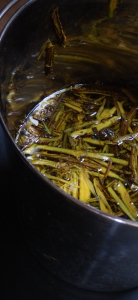 Barberry bark, one source of local and natural colour at Anna Champeney Estudio Textil (April 2012)
Barberry bark, madder root, dried cochineal and walnut husks are all sources of natural colour used to create the textiles at the weave studio of textile designer Anna Champeney in north Spain. The studio´s collections include limited edition double-weave linens, double-sided scarves in richly-coloured silk and wool, and a range of linen and wool textiles for interiors, including cushions, storage bags and decorative wall-dividers. The designs vary with each collection but what unites all these textiles is the rich and harmonious use of natural colour. The reality is that the colours produced by natural dyes are different to most synthetic dyes today because the complex formulas of natural plant dyes – a single plant may contain several dyes which combine to produce a particularly rich or subtle colour – are usually too expensive to produce in the context of industrial textile production.
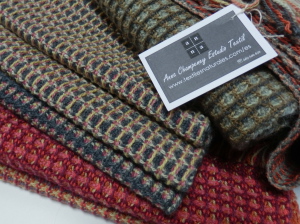 Anna Champeney textile collection 2011-12 - waffle weave scarves in silk and wool with natural dyes
This makes natural dyes the ideal choice for certain designers and specialist artisans who seek to produce a high-end product and who also care about the way that textiles are made today and the impact on the natural world. “I started working with natural dyes as it seemed the obvious choice given the location of the textile studio in rural north Spain where there was an abundance of natural dyestuffs. Of course, I was also interested in making a more organic or natural product. For me this meant sourcing dyestuffs as locally as possible, using processes which were efficient, with little waste, and avoiding chrome as a fixative ” commented Champeney.
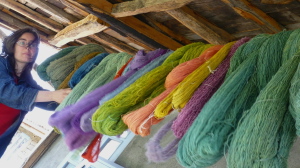 Drying yarns dyed with lichen, gorse, indigo and madder at Anna Champeney Estudio Textil in north Spain
The quality of the colours produced was also a factor. “As a textile designer and craft weaver you often find yourself limited by the commercial colour ranges. By dyeing my own colours I can achieve incredibly varied and subtle colour blends which lend a special quality to the finished textiles. This gives me a certain freedom which industrial designers simply do not have”. Marta Bahillo – Spanish knit designer – opts for natural dyes
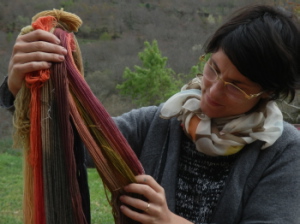 Marta Bahillo, Spansh knit designer, discovers the subtle colours of natural dyes
Marta Bahillo, a young Spanish knit designer is also moving in this direction which was why she decided to spend time at AC Estudio Texil for some intensive colour tuition. Working with natural dyes for the first time was nothing short of a revelation for this designer, whose working practice up until now always involved off-the-peg synthetically-coloured yarns. “I really feel the course has changed me because I see colour in a different way now”, commented Bahillo, “I can see subtle changes in tone which I didn´t notice before”. Moreover, Bahillo was particularly struck by the sheer variety and richness of the colours obtained using natural dyes. In the context of her work as a knit designer Bahillo sees definite advantages in being able to have a greater control over the final result. Working directly with the dyes gives her a far greater creative involvement in the process, leading her to comment “As a textile designer I feel more confident than before”. Natural Dyes and Fashion But what about the dictates of fashion which result in certain colours dominating the market every year. Is it important for these new designers to look at colour forecasts for fashion? Champeney thinks not. “My clients tend to have a confidence in their own sense of style and colour and choose colourways which suit them rather than to follow the dictates of the fashion industry. They may combine my textiles with clothing from branded fashion but their style is definitely an individual style which is unique to them. The challenge for independent designers or makers not to follow fashion but to make textiles which are so distinctive and beautiful that each piece becomes a personal classic in its own right”. More information:
- Inquiries about Anna Champeney Estudio Textil´s limited edition textile collections – please contact the studio.
- Textilesnaturales hopes to feature Marta Bahillo again in a future feature.
 original hand-woven fabric design for bag and shoes by Adele Orcajada, textile apprentice at Anna Champeney Estudio Textil (Galicia, Spain)  Adele, you´ve worked in the world of fashion and accessories for quite some time now, so you know this industry well. Tell us a bit about your professional career. Adele, you´ve worked in the world of fashion and accessories for quite some time now, so you know this industry well. Tell us a bit about your professional career.
I was a graphic designer but then did a Masters in accessories´ design. Since then I´ve worked for different types of businesses but all related to fashion. I started in a small craft studio specialising in shoes in Madrid – Franjul. Then I worked for Sfera (clothing brand of the Corte Inglés chain) and Zara and other small companies producing for the luxury market. ¿Typically how many of one particular kind of bag might industry produce for a seasonal collection? It depends on the kind of company. A multinational might produce up to 240,000 of one design in one particular colour, but a high-end luxury brand might produce just 200. ¿What would you say are the hallmarks of a quality bag? A well-made bag has fittings which don´t change or lose their colour, metal zips – where the colour of the zip isn´t lighter than the colour of the leather. If possible it should be exactly the same colour, and this is also true for the colour of the thread used to sew the piece. The lining should never be of polyester! In your opinion can hand-made bags compete with industry? Clients for hand-made bags are different, so I believe industry and craft are not in competition. The person buying a hand-made bag pays more for higher quality and for the distinctive and unique character of the bag, as long as, of course, it is well designed as well as well-made. ¿What are some of the advantages and disadvantes that a craftsperson has compared to industry? The craft maker has a freedom to define their overall design brief and he or she isn´t so limited by fashion trends. The disadvantages include the limited access to raw materials: the minimum orders that suppliers insist on are just too big for small craft producers. ¿What advice or tips can you offer deigner-weavers who want to design their own bags? I´d recommend that they remember that the main feature of the bag is the fabric itself, rather than the bag. Making and designing bags can be a complicated business – it is, after all, a sector in its own right. When a weaver designs a bag they would do well to think of something simple or else seek advice and help from an expert in bag design, or work on a design in collaboration. You´ve been working and training at Anna Champeney Estudio Textil, a small fabric weaving studio in rural northwest Spain this November. Can you tell us a bit about the work you´ve been doing? 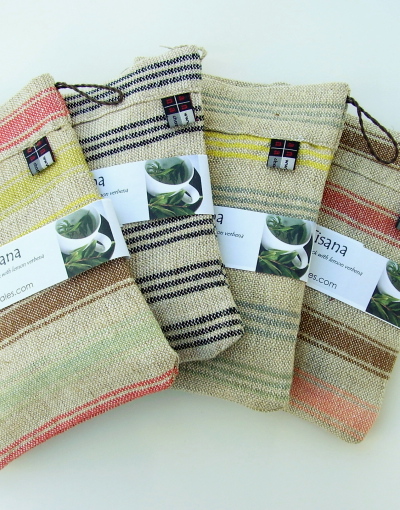
I´ve been helping Anna to make up some of the studio´s products for sale in the shop, and I´ve also learned a lot about the theory necessary for understanding basic weaving design – how to set up a loom, select the fabric structure, select yarns correctly… Then I´ve put all of this into practice in the design and weaving of a final project – in my case – fabric for a bag and matching shoes. 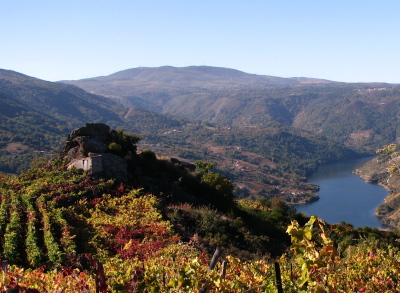 You´re used to living in Madrid, so coming to rural northwest spain has been quite a change for you. What have your impressions been of the village of Cristosende where the textile studio is based, and the surrounding Ribeira Sacra area? You´re used to living in Madrid, so coming to rural northwest spain has been quite a change for you. What have your impressions been of the village of Cristosende where the textile studio is based, and the surrounding Ribeira Sacra area?
It´s a very peaceful area, perfect, in fact, for concentrating on learning to weave. The landscape is also very inspiring, for its colours, textures, and light. What has been the main challenge of learning to weave? Setting up the loom in such a way that the final result is similar to the orginal idea I had in my head. The best part has been being able to improvise once the loom was set up, and just play with all the different possibilities for using colour and texture.
 - Tela para bolso y bailarinas de Adele Orcajada, el proyecto final de su tiempo como aprendiz en el taller textil de tejedora Anna Champeney en Galicia
Visit the Anna Champeney online textile and basket shop – we are now open for christmas Contact us for more I´ve just come back from the European Textile Network conference and Kaunas Textile Biennial and the textilesnaturales textile blog is officially “on holiday” … but I just cannot help but post some images up. I´ll be blogging more about my impressions later on in October and November, but let me just say it was a full-on 4 days with exhibition openings, courses, talks and networking presentations to let you know what is coming up in 2012, 2013 and further ahead, in countries around the world. For anyone involved in textile art (and to a lesser extent design, fashion or contemporary craft) and anyone who, like me, specialises in loom-woven textiles, the conference and bienial was a really special opportunity.  Exhibition of Nuno Textiles at Kaunas (Lithuania) 2011  One of the highlights, for me, was meeting and talking with Reiko Sudo of Nuno (the innovative textile design company run by Reiko – and a particular favourite of mine!), with the opportunity to learn rust dyeing with her in her course entitled “Rust never sleeps”. Such a simple, yet effective technique, with lots of possibilities to explore. Reiko had a solo exhibition with a number of her fabulous fabrics on display, as well as samples to touch and a display of some of the ways in which Nuno fabrics start out – collage, paper models and drawing. One of the highlights, for me, was meeting and talking with Reiko Sudo of Nuno (the innovative textile design company run by Reiko – and a particular favourite of mine!), with the opportunity to learn rust dyeing with her in her course entitled “Rust never sleeps”. Such a simple, yet effective technique, with lots of possibilities to explore. Reiko had a solo exhibition with a number of her fabulous fabrics on display, as well as samples to touch and a display of some of the ways in which Nuno fabrics start out – collage, paper models and drawing.
There were numerous other group exhibitions in various museums and galleries around Kaunas. In the four days I was there there was hardly a minute to digest so much new information, and get to know other conference delegates more. But I know I have made new friends there and have been immensely enriched as a result. Perhaps the only thing that I felt was really missing from the event was the organisation of discussion groups, perhaps on themes, which would have encouraged active debate and participation and act as a conduit for and catalyst for new initiatives and ideas. Such groups would also have been a valuable opportunity for newcomers to the ETN conference to really get to know other delegates better, although I found the conference atmosphere to be generally very friendly, and most people very open.  New book on Korean Bojagi textiles by artist and educator Chunghie Lee It was also a pleasure to meet and talk with Korean textile artist Chunghie Lee and get hold of her new book, Bojagi and Beyond (ISBN978-0-9830029-0-1). As one of my main research interests is traditional peasant textiles of Galicia, north Spain, and their development and use in contemporary textile design and art, it was fascinating to learn about the traditional Korean textile technique of Bojagi (similar, but different to patchwork) and the way that Chunghie has taken this and made it known worldwide. In the preface to her book Chunghie talks about the “thousands of nameless ancestral women” making the bojagi textiles “stitched by their hands and from their hearts”. There is something essential and refreshing about these traditional textile techniques – and contemporary works inspired by them – which sometimes seems to be missing from some contemporary art textiles.  Traces by Ainsley Hillard (Wales). 2008. But it was good to see some of the work by contemporary textile artists such as Ainsley Hillard – whose work I have only seen online or in publications up until now (you don´t find many contemporary international textile exhibitions in north Spain these days!) who does seem to be able to capture the ghosts of the past – of both people and places – in her subtle textile installations. Jacquard loom weaving, unsurprisingly, had a very strong presence in the conference and exhibitions – as a future face of contemporary textile art and cutting edge industrial textile design, and with huge potential for arquitectural applications. Vibeke Vestby gave an exciting presentation about her work in the development of the TC2, a new design of computer Jacquard available for the first time, commercially, later in 2011. I wish I could show here the images of the wonderful upholstery produced using the new TC2 that she presented in her lecture. Jacquard weaving is often used to translate – or incorporate – photographic images into woven cloth – Lia Cook (USA) is a leading artist in this field and her work was on display in one of the exhibitions – but it has other applications which are equally exciting. As a hand-weaver, limited to my eight shaft countermarch loom, the idea of a Jacquard loom which enables you to lift up a different combination of warp ends in every pick seems truly liberating. But then again, technical limitation in weaving is something that every weaver comes up against, whatever tool is being used, and limitations represent catalysts for creativity. Jacquard weaving is not a possibility for every weaver, for reasons of cost, access to markets or geographical location. Living in a rural area of Spain, however much I feel attracted to the idea of complex weaves possible on a Jacquard, I don´t feel it is technology that I can easily adapt to at the moment. But thanks to the conference I feel I will definitely pay more attention to Jacquard weaving in future. Special thanks go to Beatrizs Sterk, of ETN, who organised the conference; a huge amount of work and, which I, like most others, cannot adequately appreciate, acknowledge or thank.
|
Pago seguro
 NUEVO Octubre 2023 Curso presencial setmanal de teixits de baix lliç (Girona)!Un curso nou, setmanal (3h) a Sant Gregori, Girona, amb l'Anna Champeney. Trimensual, plaças limitadas).
Octobre 2023. Ven a aprender a diseñar y realizar tejidos en telar de bajo lizo a mano. Docente: Anna Champeney, profesional desde 2004, con marca textil propia, experta en tejido de bajo lizo, docente en la Escola Massana, Barcelona.
 Haga clic aquí para informarte |







 Adele, you´ve worked in the world of fashion and accessories for quite some time now, so you know this industry well. Tell us a bit about your professional career.
Adele, you´ve worked in the world of fashion and accessories for quite some time now, so you know this industry well. Tell us a bit about your professional career. 
 You´re used to living in Madrid, so coming to rural northwest spain has been quite a change for you. What have your impressions been of the village of Cristosende where the textile studio is based, and the surrounding Ribeira Sacra area?
You´re used to living in Madrid, so coming to rural northwest spain has been quite a change for you. What have your impressions been of the village of Cristosende where the textile studio is based, and the surrounding Ribeira Sacra area? 



International art textile exhibitions, conference and networking opportunity (ETN and Kaunas Biennial) September 2011
I´ve just come back from the European Textile Network conference and Kaunas Textile Biennial and the textilesnaturales textile blog is officially “on holiday” … but I just cannot help but post some images up. I´ll be blogging more about my impressions later on in October and November, but let me just say it was a full-on 4 days with exhibition openings, courses, talks and networking presentations to let you know what is coming up in 2012, 2013 and further ahead, in countries around the world. For anyone involved in textile art (and to a lesser extent design, fashion or contemporary craft) and anyone who, like me, specialises in loom-woven textiles, the conference and bienial was a really special opportunity.
Exhibition of Nuno Textiles at Kaunas (Lithuania) 2011
There were numerous other group exhibitions in various museums and galleries around Kaunas. In the four days I was there there was hardly a minute to digest so much new information, and get to know other conference delegates more. But I know I have made new friends there and have been immensely enriched as a result. Perhaps the only thing that I felt was really missing from the event was the organisation of discussion groups, perhaps on themes, which would have encouraged active debate and participation and act as a conduit for and catalyst for new initiatives and ideas. Such groups would also have been a valuable opportunity for newcomers to the ETN conference to really get to know other delegates better, although I found the conference atmosphere to be generally very friendly, and most people very open.
New book on Korean Bojagi textiles by artist and educator Chunghie Lee
It was also a pleasure to meet and talk with Korean textile artist Chunghie Lee and get hold of her new book, Bojagi and Beyond (ISBN978-0-9830029-0-1). As one of my main research interests is traditional peasant textiles of Galicia, north Spain, and their development and use in contemporary textile design and art, it was fascinating to learn about the traditional Korean textile technique of Bojagi (similar, but different to patchwork) and the way that Chunghie has taken this and made it known worldwide. In the preface to her book Chunghie talks about the “thousands of nameless ancestral women” making the bojagi textiles “stitched by their hands and from their hearts”. There is something essential and refreshing about these traditional textile techniques – and contemporary works inspired by them – which sometimes seems to be missing from some contemporary art textiles.
Traces by Ainsley Hillard (Wales). 2008.
But it was good to see some of the work by contemporary textile artists such as Ainsley Hillard – whose work I have only seen online or in publications up until now (you don´t find many contemporary international textile exhibitions in north Spain these days!) who does seem to be able to capture the ghosts of the past – of both people and places – in her subtle textile installations.
Jacquard loom weaving, unsurprisingly, had a very strong presence in the conference and exhibitions – as a future face of contemporary textile art and cutting edge industrial textile design, and with huge potential for arquitectural applications. Vibeke Vestby gave an exciting presentation about her work in the development of the TC2, a new design of computer Jacquard available for the first time, commercially, later in 2011. I wish I could show here the images of the wonderful upholstery produced using the new TC2 that she presented in her lecture. Jacquard weaving is often used to translate – or incorporate – photographic images into woven cloth – Lia Cook (USA) is a leading artist in this field and her work was on display in one of the exhibitions – but it has other applications which are equally exciting. As a hand-weaver, limited to my eight shaft countermarch loom, the idea of a Jacquard loom which enables you to lift up a different combination of warp ends in every pick seems truly liberating. But then again, technical limitation in weaving is something that every weaver comes up against, whatever tool is being used, and limitations represent catalysts for creativity. Jacquard weaving is not a possibility for every weaver, for reasons of cost, access to markets or geographical location. Living in a rural area of Spain, however much I feel attracted to the idea of complex weaves possible on a Jacquard, I don´t feel it is technology that I can easily adapt to at the moment. But thanks to the conference I feel I will definitely pay more attention to Jacquard weaving in future.
Special thanks go to Beatrizs Sterk, of ETN, who organised the conference; a huge amount of work and, which I, like most others, cannot adequately appreciate, acknowledge or thank.